The gen set is much happier now
During the process of troubleshooting our recent inverter/charger issues, we had a new friend named Chris take a look at our generator to check the electrical output. While he was in the locker, he pointed out the obvious salt buildup on the backside of the generator. To be honest, I had noticed that salt myself but was not aware of the cause, nor how serious it could be. Chris explained that if the rubber boot on the output of the heat exchanger goes bad, or the exhaust elbow itself, the super hot salt water exiting the heat exchanger can leak out, leaving behind the deposits that we were seeing. He also explained that if this salt water sprays onto the back end of the generator, it can cause a lot of very expensive damage. That was all I needed to hear. So began a serious repair job.
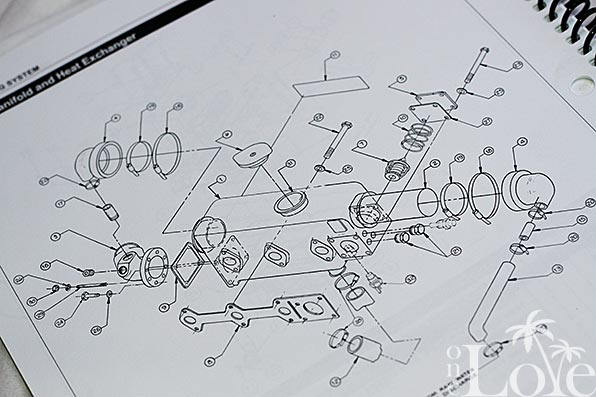
While I wasn’t before I tackled this job, I am now intimately familiar with this assembly!
We moved One Love around to Compass Point Marina, our typical charter staging area. It’s not only convenient to be on the dock for big repairs, All Points Marine, the local Northern Lights generator dealer, just happens to be located in the Compass Point Marina complex. I had called ahead to All Points to ask if they had the replacement boots and exhaust elbow that we wanted in stock and while they didn’t, Tracy, the manager there, ordered them right away so that they would be delivered on the ferry later that same day. When I went to pick up the parts, the guys in the shop actually laughed when I said that I was going to tackle the job myself. They knew how hard it was going to be. Believe me though, I had no illusions that it was going to be easy!
When I began cleaning away the salt deposits on the generator, I found that two of the hose clamps holding the rubber boot on the output of the heat exchanger had broken in half. Could it have been leaking because they broke or did they break because the boot was leaking salt water? Regardless of which came first, we decided to go ahead and strip everything down, replacing the rubber boots and the exhaust elbow, just in case.
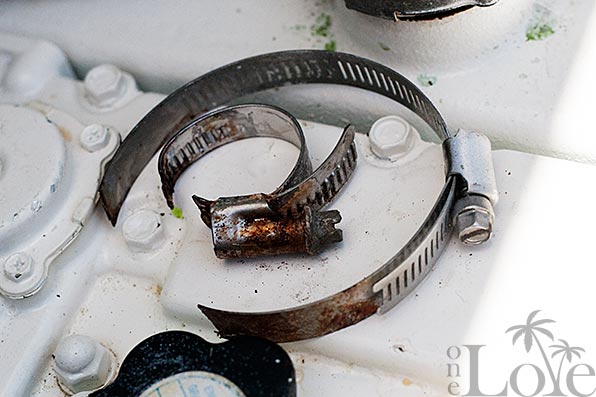
Was the heat exchanger leaking because these clamps broke,
or did they break because the boot was leaking salt water?
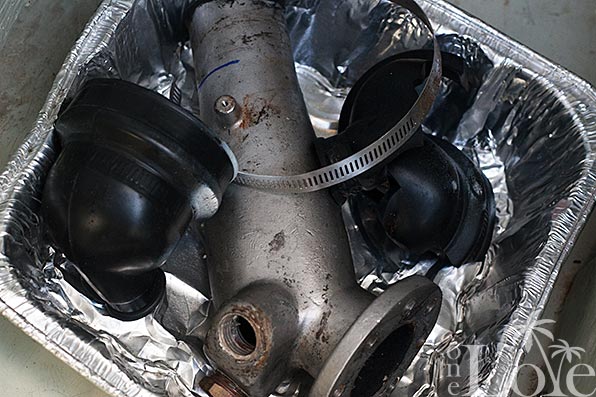
The old boots and exhaust elbow. I had to cut one of the boots off.
While the process in theory is simple enough, wrestling with the hoses, clamps, and the almost impossible-to-access bolts was anything but simple. As Tracy had warned us, there was a lot of swearing going on. And grunting. And sweating. Did I mention swearing?
While it likely took me far more time than it would have taken a pro with experience, I am happy to report that we ultimately did get the repair completed. No, the guys at All Points didn’t think that we would, and actually shared that with Michael when he stopped into their shop. I will admit it was a tough job, and not one that I’m eager to repeat. The leaking water has stopped though, and the water output at the exhaust has noticeably increased, leading me to believe that the generator is much happier now that we’ve fixed everything.
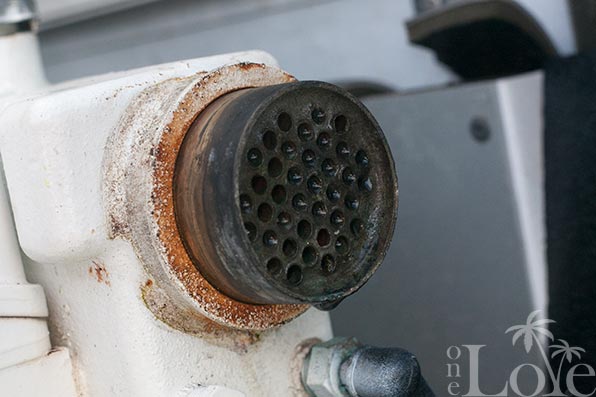
The core of the heat exchanger is now exposed.

I found these broken bits of impeller stuck at the core input. They are not from the current impeller and thus have likely been there since we took possession of the boat.

The guys at All Points cleaned the core for us by soaking it in Muriatic Acid.
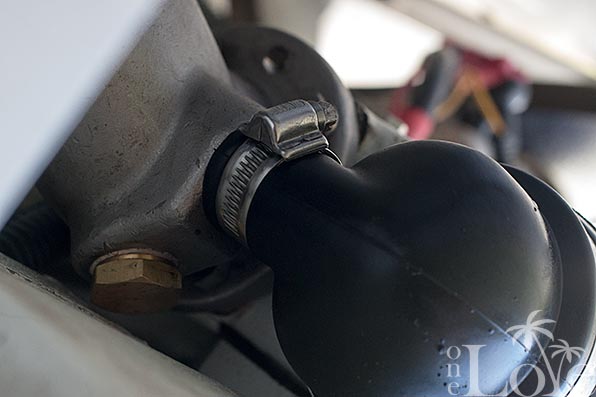
Starting the reassembly with all new parts.

The old exhaust elbow. It was suggested that we use oven cleaner to try to clean it out.



Yes oven cleaner works well. Warm it up first and clean it way far away from the boat! And wear gloves, that stuff will take a layer of skin of too..
Congratulations for reading all the way to the last caption. 🙂
Well done! All that swearing does work! Cheers
🙂
It makes me feel better if nothing else.
Just take the old exhaust elbow to a radiator shop for a cleaning. Save yourself from the trouble and fumes from the oven cleaner!
Certainly an option but when you live on a boat as we do, without access to a car, taking parts to a shop is often not easier than doing something yourself, nor is it as cost effective.
Well Done!! I wish I was there to help…
Not much room for a second body in that locker! 🙂
I call it ‘grunt work’ and it never matters how much time it takes to get it done, my labor is free. Of course if you were chartering you wouldn’t have had the “luxury” time wise, of that grunt work 🙂
I never consider my labor as free. My time has value. I charged a hundred per hour for private lessons back at our gym. I always equate my time in that manner.
As always, an interesting read.
Again I’m reminded about how the job you’re doing (i.e. – professional charter) calls for such an extreme range of skills and more meaningfully – a real devotion to your work, be it cooking, entertaining, planning, sales, blogging, ship repair, etc. etc.
A Jack and Jill of all trades. 🙂
Impressive job Mike..
Congrats
Fred
Thanks, Fred!
I have a Northern Lights and it purred like a kitten and was my favorite piece of trouble free gear on our boat. Then without any warning at 1000 hours it all of a sudden would not make full RPM or AC power. Long story short I discovered (the expensive way) the typical failure mode of the exhaust elbow. It slowly clogged up and created too much back pressure and burned all three exhaust valves. I had to pull the head and have a top end rebuild. Word to the wise, pull the exhaust elbow every year and clean it out, inspect it and either reinstall or replace it as necessary. A $250 elbow is a whole lot cheaper than a 3K top end rebuild.
I also found many pieces of old impellers in the heat exchanger from the previous owners. It is a learning curve and I believe sharing info will save us all $$$ in the end.
Love your blog, keep up the good work.
Ken
Wow. That happened after only 1000 hours? We have over 10k on this guy.
You should probably check your Yanmar manual. Mine calls for the mixing elbows to be replaced every 500 hours 🙁
That ain’t happening.
Another great maintenance/repair tip that will come in very handy for us when we start cruising our L46. Thanks Mike! We greatly appreciate the time you put into these helpful posts and the photos!
Rob
You’re welcome, Rob. It’s not that complicated. It’s just a bear dealing with the hard to access parts.
Thought of you two when I walked the dog at Lemoines today. A few boats have been splashed at Collins Bay.
Only a few? Come on warm weather!
Working on an engine exposed to salt can even slow down a professional technician, all you need is that one rusted nut or bolt that rounds off when you put a wrench on it and now you have a project, or worst case the bolt that breaks. Swearing comes with the trade along with bloody knuckles and bleeding arms from scratches you get from reaching into tight places. Looks like a job well done.
I had a few cuts and bruises from this one.